
-
Find the right food for your petTake this quiz to see which food may be the best for your furry friend.Find the right food for your petTake this quiz to see which food may be the best for your furry friend.Featured products
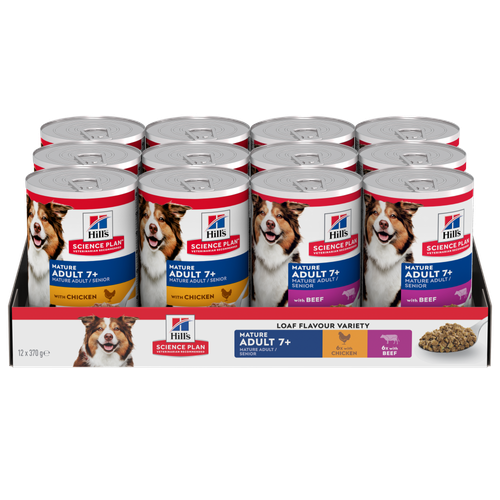 Mature Adult Dog Food
Mature Adult Dog FoodHill's Science Plan Mature Adult Multipack Wet Dog Food with Chicken & Beef are complete premium pet foods for mature adult dogs from 7 years. Your dog will love these deliciously smooth and savoury minced loaves, formulated to deliver the appropriate amount of energy to support the needs of adult dogs.
Shop Now Adult Wet Dog Food with Beef
Adult Wet Dog Food with BeefHill's Science Plan Adult Multipack Wet Dog Food with Chicken, Beef & Turkey are complete premium pet foods for adult dogs from 1 year. Your dog will love these deliciously smooth and savoury minced loaves, formulated for balanced nutrition and overall health.
Shop Now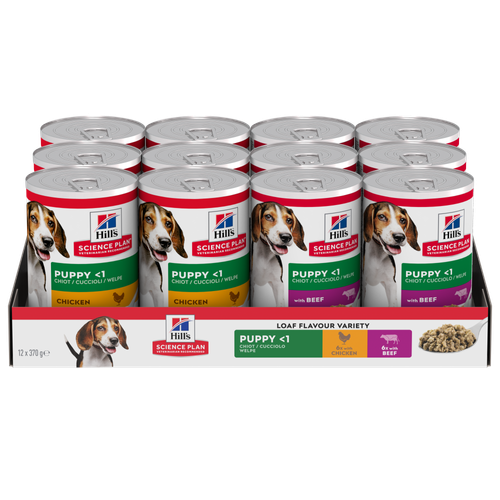 Puppy Food
Puppy FoodHill's Science Plan Puppy Multipack Wet Dog Food with Chicken & Beef are complete premium pet foods for growing puppies from weaning until 1 year old and for pregnant and nursing dogs. Your puppy will love these deliciously smooth and savoury minced loaves, formulated for balanced nutrition and overall health.
Shop NowFeatured products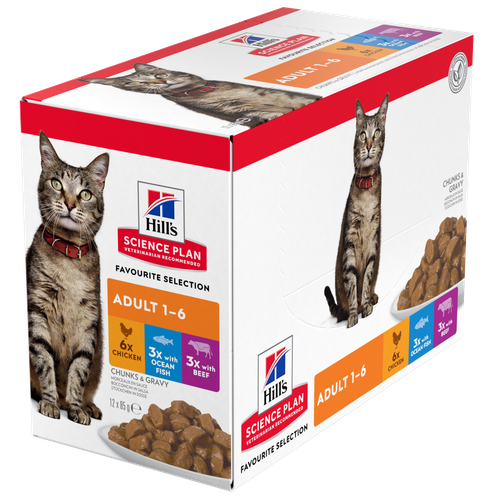 Adult Multipack Wet Cat Food with Beef, Ocean Fish & Chicken
Adult Multipack Wet Cat Food with Beef, Ocean Fish & ChickenTender chunks in gravy for cats, with high-quality protein to maintain lean muscle. With vitamin E and omega-3s & -6s for healthy skin and balanced minerals to support healthy vital organs.
Shop Now Light Adult Multipack Wet Cat Food with Chicken & Ocean Fish
Light Adult Multipack Wet Cat Food with Chicken & Ocean FishTender chicken chunks in gravy for cats, with L-carnitine and fewer calories for ideal weight management. Packed with high-quality protein, omega-6s, and vitamin E for shiny fur and healthy skin.
Shop Now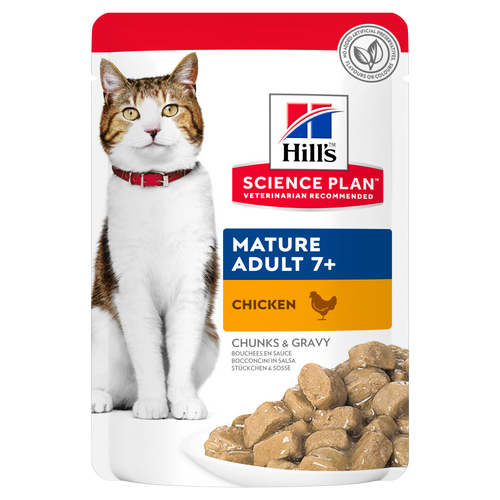 Mature Adult Wet Cat Food with Chicken
Mature Adult Wet Cat Food with Chicken
Tender chicken chunks in gravy for mature adult cats. Made with easy-to-digest ingredients, high-quality protein for lean muscle maintenance and antioxidant vitamins C+E for optimal health.
Shop Now -
Dog
- Dog Tips & Articles
-
Health Category
- Weight
- Food & Environmental Sensitivities
- Urinary
- Digestive
- Joint
- Kidney
-
Life Stage
- Puppy Nutrition
- Adult Nutrition
- Senior Nutrition
Cat- Cat Tips & Articles
-
Health Category
- Weight
- Skin & Food Sensitivities
- Urinary
- Digestive
- Kidney
-
Life Stage
- Kitten Nutrition
- Adult Nutrition
Featured articles Show some love with wet foods: a great choice for pets with health issues
Show some love with wet foods: a great choice for pets with health issuesShow some love with wet foods: a great choice for pets with health issues.
Read More The Incredible Science Behind Your Pet's Microbiome
The Incredible Science Behind Your Pet's MicrobiomeLearn what your pet's microbiome is, how it contributes to your pet's gut and overall health, and why nutrition is important in maintaining healthy microbiomes.
Read More The Right Diet For Your Pet
The Right Diet For Your PetIn people, the right diet is very important. If you are eating the wrong way for your metabolism, activity level, age and lifestyle you could end up with health issues.
Read More -



Halloween may be one of the best nights of the year for children, but it can be a daunting and scary night for your dog. Here are some tips to ensure that all family members – dogs included – enjoy a fun and safe Halloween.
Does the doorbell drive your dog wild?
Dogs can easily become over-excited, agitated or frightened when the doorbell rings, so the constant ringing from trick-or-treaters in strange clothes and masks may be a very stressful experience for your dog. It’s upsetting for some adults, too! Keep your dog confined to as large an area of the house as possible, that does not have access to the front door. This way, they can choose where they want to be and hide away if they need to. If you have a barker, keeping your dog away from the front door will also stop them from frightening children.
Many new smart doorbells allow you to turn off the chime for a period of time. If you know that your dog may find the experience stressful, consider muting your doorbell and leaving a sign asking trick-or-treaters not to knock.


Tasty Tips
Limit stress by planning ahead
It’s probably best to avoid walking your dog when the trick-or-treating is in full swing. As we said, costumes and masks can be very stressful for dogs. They are animals that are really good at reading human faces, so when those faces are covered or made up to look different, this can cause fear. It could also provoke unwanted and unusual behaviour, like barking and lunging.
Get your walk done earlier in the day or work your dog’s brain using indoor or garden enrichment activities, rather than taking them on a walk during peak Halloween hours. If you feed your dog a dry food, then consider placing their food around the garden or house, getting them to use their nose and their brain to hunt out their food. This type of enrichment can be very rewarding and, in a pinch, it may do well as a replacement for their regular evening walk.
If you do decide to walk your dog in the evening when trick-or-treaters roam the streets, be sure to use a sturdy collar, or a harness and lead, and be careful around unfamiliar children and adults. Try to steer clear of large groups of costumed children, and also away from busy roads where a scared and stressed dog may be at risk. A scared dog may try to bolt from – or even warn off – unfamiliar figures, so no matter how well you know your dog, be extra cautious.
Best practices for all seasonal events
Be sure your dog is wearing identification tags with your name and phone number on them in case you become separated or they escape from the house. Microchipping is the surest way to make sure your dog will be reunited with you if they escape. Do NOT dress your dog up at Halloween, or at any other time of year. It may be fun for us humans, but many animals find this stressful, restrictive or uncomfortable.
Lastly, keep all sweets and chocolate out of your dog's reach. Chocolate is highly toxic to dogs and consumption of even small amounts can cause seizures, muscle tremors, vomiting and, in larger doses, even death. The artificial sweetener, xylitol, is found in many sweets, and is also highly toxic to dogs. It causes low blood sugar (hypoglycaemia), seizures and liver failure. Stick to dog treats and your dog will be just as happy.
Following these simple tips will help keep your dog safe, healthy and out of any scary trouble this Halloween.
Reviewed by Dr. Hein Meyer, DVM, PhD, Dipl-ECVIM-CA and Dr. Emma Milne BVSc FRCVS


One of our staff authors prepared this article for you
Related products

Hill's Science Plan Puppy Multipack Wet Dog Food with Chicken & Beef are complete premium pet foods for growing puppies from weaning until 1 year old and for pregnant and nursing dogs. Your puppy will love these deliciously smooth and savoury minced loaves, formulated for balanced nutrition and overall health.

Hill's Science Plan Adult Multipack Wet Dog Food with Chicken, Beef & Turkey are complete premium pet foods for adult dogs from 1 year. Your dog will love these deliciously smooth and savoury minced loaves, formulated for balanced nutrition and overall health.

Hill's Science Plan Mature Adult Multipack Wet Dog Food with Chicken & Beef are complete premium pet foods for mature adult dogs from 7 years. Your dog will love these deliciously smooth and savoury minced loaves, formulated to deliver the appropriate amount of energy to support the needs of adult dogs.
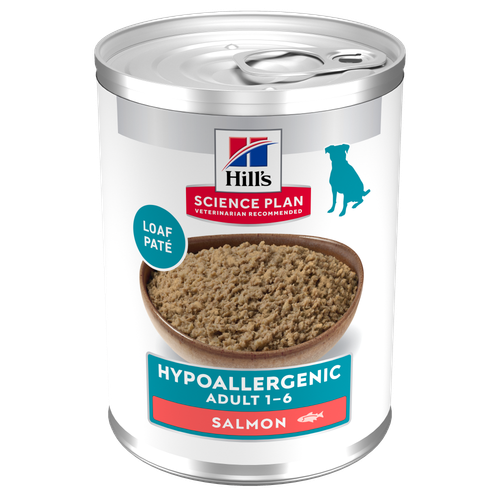
Hill's Science Plan Hypoallergenic Adult Wet Dog Food with Salmon is a complete premium pet food for all adult dogs from 1 year. This savoury tinned loaf is specially formulated for dogs with delicate skin and stomachs. It features a single novel animal protein source and is grain-free.
Related articles

How, when and what to feed your new puppy is an important decision, learn more about the things to consider for feeding your puppy.

Learn about the potential health risks of a raw diet for dogs and why they aren't the best option for your pup or you.

Many human foods are dangerous to dogs. Read about 5 of the worst toxic food offenders that can kill your dog - and how much it takes to hurt them.

Learn effective tips for feeding a dog that's a picky eater and ensure proper nutrition for a finicky eater. Discover tips for pet parents at Hill's Pet UK.

Put your dog on a diet without them knowing
Our low calorie formula helps you control your dog's weight. It's packed with high-quality protein for building lean muscles, and made with purposeful ingredients for a flavourful, nutritious meal. Clinically proven antioxidants, Vitamin C+E, help promote a healthy immune system.
Put your dog on a diet without them knowing
Our low calorie formula helps you control your dog's weight. It's packed with high-quality protein for building lean muscles, and made with purposeful ingredients for a flavourful, nutritious meal. Clinically proven antioxidants, Vitamin C+E, help promote a healthy immune system.

